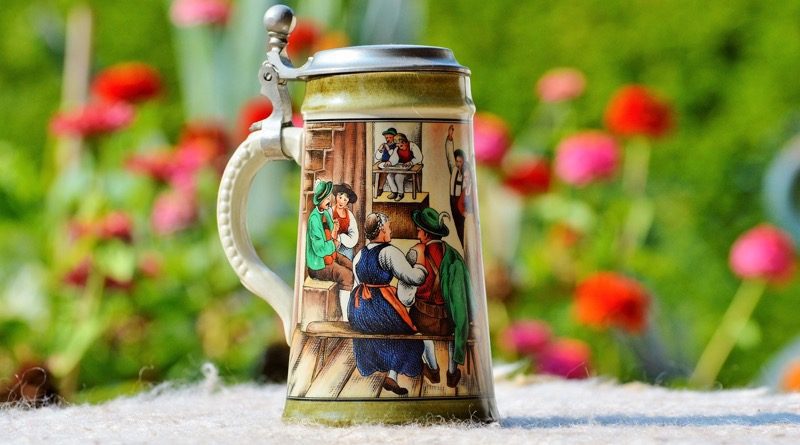7 Interesting German Beer Stein Facts
JADCOM Media posts and/or links to retailers can be advertising, sponsored, or affiliate links.
We may earn a small commission from them. Thank you.
Markus and I are very proud that you’ve trusted us to bring you the inside story of the great efforts of brewers of wonderful craft beers from both Germany, and the US. We’re just getting warmed up, with much more on the way.
At this point, I thought it would be fun to take a closer look at the vessels which hold that valuable cargo: German Beer Steins. (This will give Markus more time to explore the German Craft Beer countryside!)
Enjoy these 7 interesting facts about German Beer Steins!
1. German Beer Stein Interest is Global
Beer stein appeal seems to be universal. Sure, it might be “easier” to drink your favorite brew out of a pint glass. But think about the thrill of downing that wonderful nectar out of a classic, collectible, and often ceramic vessel.
This interest, or I might even say, “thirst,” isn’t just from Germany looking for a way to serve beer. Nope, it’s global.
That’s enough for me to ask why we should (and many do) drink German Craft Beer – or any fine beer for that matter – from German Beer Steins. Let’s explore this, shall we?
2. German Beer Steins Have A Rich History
Just as Craft Beer holds a rich and tasty history, so does the German Beer Stein. As you’re about to see, they are as beautiful as they are functional. History has played a very important role in how we see them today.
But first, some background.
3. German Beer Steins Have Great Names!
Let’s start with the basics. “Bierkrug” in German simply means “beer mug.” A bierkrug may or may not have a lid, but more on that later.
You’re probably saying, “Mug? What? I thought this was about Steins.” OK, then let’s look at the term “Stein.”
In English, “Stein” means “stone” or through evolution, ceramic. Often referred to as “Steinzeug-krug” in Germany for a more pedestrian, “stoneware mug.”
You’ve probably also heard the term “Tankard.” This is used mostly in the Berlin area and those northern German regions. The German word is “Humpen.” (OK… stop giggling!) The Tankard specifically has a handle. With the Tankard, we expand on the manufacturing materials often to glass, pewter, and brass.
Many Tankards have lids, but again, more on that in a moment.
There are many, many more terms that have been used throughout history. Some are regionally used; some are more universal. For now, this gives you a bit of a primer on the tool used to consume your favorite Craft Beer!
4. The Lid is Historically Important
This discussion will take two paths. First, let’s think about the stein as a “mug.” It is large, it is ornate, it has a hefty handle, it is fun to hoist, and holds plenty of beer. That’s the enjoyable “Oktoberfest” type of fantasy most of us outside of Germany hold in our heads. (Sorry, Markus… I sort of think this way, too!)
Digging deeper into history though, gives us the second leg of this journey and a more practical description that includes the hinged lid. Finally!
Enter “the lid.”
It is believed that near the end of the 1400s, Central Europe was often plagued, but this time with small flies. Early in the next century, many regions enacted food safety laws to help. One of those included the requirement to cover beverage containers.
Necessity is the Mother of Invention!
Innovation took hold immediately, and the hinged lid, actuated with a flick of the thumb, was born!
You’re welcome!
This is just a brief snippet into the over 400 year history of how beer has been served and sipped. There is a very good chance that this is whetting your whistle for more. The Beer Stein Book by Gary Kirsner is a great way for you to get all the history you can drink.
5. German Beer Steins are Crafted, not Manufactured
As Markus and I have sought, enjoyed, and evaluated different kinds of beers over the years, we’ve come to enjoy quite a variety. In addition, we’ve learned quite a bit. However, that seems to pale in comparison right now as I just learned about how German Beer Steins are made.
This. Blew. Me. Away.
Enjoy the video!
Granted, there are likely many different approaches to creating a German Beer Stein. This is but one method.
(If the truth were known, I may or may not have watched this video way too many times!)
Wow!
6. German Beer Steins Have Many Varied Styles
It should be quite obvious the people who make German Beer Steins are artists. Pure and simple. Think about the original carved design that led to the mold in the video above. Then, consider the painting creativity that allows for so many variations of just one stein design.
Artistic indeed.
With any artistic endeavor, the sky really is the limit – a limit imposed only by an artist’s creativity. Let’s take a look at a variety of styles that are available. This takes German Beer Steins beyond function and well into collector territory.
These are some very interesting designs and I’ll keep adding more as I find them. If you find one you’d like to contribute, get in touch!
All the mugs shown below are available on Amazon.
7. German Beer Steins are Collector Items
If you have gotten this far into my Beer Stein Fun, you might be coming down with a case of “becoming a collector!” If so, let’s talk for a moment about how to enjoy this new-found hobby.
First, think about how you might collect them. One way of course is to seek out breweries when you travel If a commemorative stein is available, well, wouldn’t that be a stylish AND functional souvenir?
I thought so.
Next, think about your growing collection. About the passion that comes from having a souvenir tasty treasure from your visit! So, how do you show them off?
In the video below, produced by Shenandoah University in Winchester, Virginia, you’ll not only see a great collection, but some ideas for displaying it as well.
We can all hope to be as lucky as this gentleman some day!
Getting Started
Now the ball’s in your court… er… ah… the stein is on your table. You have enough to get you started down the path toward an historic and tasty hobby. Not only the beer, but also the containers in which it is consumed.
I won’t be looking at German Beer Steins the same way in the future and I doubt you will, either.
Prost!
Dave



